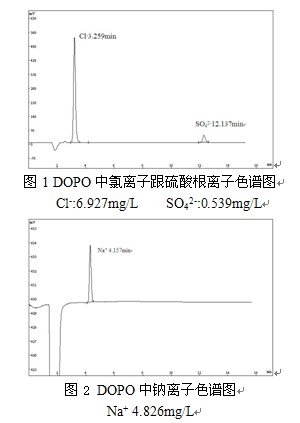Welcome to the official website of Qingdao Puren Instrument Co., Ltd
Abstract: In this paper, chloroform was used as extractant, DOPO was dissolved, centrifuged and centrifuged, autosampler - two-channel ion chromatography was used to detect inorganic anions and cations in DOPO. The autosampler was used to synchronize with the dual channel. Greatly reducing the analysis time. Ion retention time RSD (n = 6) is 0.07% ~ 0.18%, peak area RSD (n = 6) is 0.43% ~ 0.88%. High reproducibility and satisfactory results.
Keywords: DOPO, autosampler, dual channel, ion chromatography, simultaneous, inorganic anion
DOPO (chemical name: 9,10-dihydro-9-oxa-10-phosphaphenanthrene-10-oxide) is a new flame retardant intermediates, with more than the general organic phosphate thermal stability and chemical stability High, flame retardant performance better features. DOPO and its derivatives can be used as reactive and additive flame retardants, synthetic flame retardant halogen-free, smoke-free, non-toxic, non-migration, flame retardant performance lasting. Can be used for linear polyester, polyamide, epoxy resin, polyurethane and other polymer materials flame retardant treatment. Foreign has been widely used in electronic equipment with plastic, copper lining layer, circuit boards and other materials, flame retardant.
However, DOPO in the process of synthesis will introduce a small amount of halogen or inorganic cations, the existence of these ions will inevitably affect the purity of DOPO, increase the safety hazards of end products. The method provided in this paper can be completed in a short time DOPO inorganic cation and cation detection, reduce the loss of users to ensure the maximum profit.
1 experimental part
1.1 Instruments and reagents
Instrument: PIC-10A dual-channel ion chromatograph, PIC-JY autosampler (Qingdao Puren Instrument Co., Ltd.), centrifuge (Shanghai centrifuge factory), PG-2010 anti-control station, ultrasonic cleaning machine (Kunshan City ultrasound Instrument Co., Ltd.), C18 pretreatment column and 0.22mm needle filter (Qingdao Pu Ren Instrument Co., Ltd.).
Reagents: Na2CO3, NaHCO3, CH3SO3H, NaCl, Na2SO4 (analytical grade) The above drugs were purchased from Shanghai Ebi Chemical Reagent Co., Ltd., all solutions were prepared with 18.2MΩ.cm ultrapure water.
1.2 chromatographic conditions
1.2.1 Anion-column: PR1 (250 mm x 4.6 mm), mobile phase: 1.92 mM Na2CO3 + 1.8 mM NaHCO3, flow rate: 1.5 mL / min, Detector: Inductance detection, suppression current: 60 mA
1.2.2 Cationic - Column: PR2 (100mm × 4.6mm), mobile phase: 3 mM CH3SO3H, flow rate: 1.0 mL / min, detector: inhibition of conductance detection, suppression of current: 50 mA
1.3 Pretreatment methods
1.3.1 DOPO (about 0.1mg) and 20 mL of chloroform were added to the remote tube (FEP system, 50 mL). DOPO was dissolved by ultrasonic cleaning machine.
1.3.2 DOPO dissolved, add 10 mL of deionized water, the lid tightened to prevent leakage.
1.3.3 will be immersed in the deep tube 5-10min shaking, and then centrifuge separation, 4000r / min about 15min, after centrifugation, chloroform and water separation.
1.3.4 take the water layer, over C18 column and 0.22mm disposable filter, detect the concentration of ions contained.
2 Results and discussion
2.1 Anionic and cationic spectra

Figure 1 shows that there are mainly Cl-, SO42- and Na + ions in DOPO, and the contents of the three ions are 6.927mg / L, 0.539mg / L and 4.826mg / L, respectively. The charge of the cation (Na +) is 101.7% of the charge of the anion (Cl-, SO42-), which indicates the charge conservation of the ionic material extracted by this method.
2.2 Standard curve and detection limit
A series of standard solutions were arranged and the minimum detection limit was calculated at 3 times the signal-to-noise ratio (S / N = 3) under sequential chromatographic conditions. The linear equations, correlation coefficients and minimum detection limits of the three ions (n = 3) are shown in Table 1.
Table 1 Linear equations, correlation coefficients and minimum detection limits for Cl-, SO42- and Na +
Analyte
|
Analyte |
Linear equation |
Correlation coefficient/R2 |
Minimum detection limit(mg/L) |
|
Cl- |
A=80459C+4075 |
0.9999 |
0.05 |
|
SO42- |
A=20315C+7211 |
0.9995 |
0.25 |
|
Na+ |
A=50947C+10313 |
0.9996 |
0.1 |
2.3 spiked recovery rate
A known amount of three ions was added to the sample obtained in 1.3, and the spiked recovery test was carried out under the determined ion chromatographic conditions. The samples were measured three times in parallel. The experimental results are shown in Table 2.
Table 2 Sample spiked recovery
|
Analyte |
Linear equation(mg/L) |
Add concentration(mg/L) |
measured value
|
Average recovery rate |
|
Cl- |
6.927 |
5.0 |
11.835 |
95.79% |
|
11.933 |
||||
|
11.896 |
||||
|
SO42- |
0.539 |
0.5 |
1.033 |
94.87% |
|
1.044 |
||||
|
1.034 |
||||
|
Na+ |
4.826 |
5.0 |
9.773 |
98.30% |
|
9.840 |
||||
|
9.823 |
2.3 Reproducibility test
The standard samples of the three ions were continuously measured 6 times, and their retention time and peak area reproducibility results are shown in Table 3.
Table 2 Retention results and peak area reproducibility results
|
Analyte |
keep timeRSD%(n=6) |
Peak areaRSD%(n=6) |
|
Cl- |
0.18 |
0.88 |
|
SO42- |
0.14 |
0.78 |
|
Na+ |
0.07 |
0.43 |
It can be seen from Table 2 that the method is stable and reliable, reproducible.
3 Conclusion
This method dissolves DOPO in chloroform, extracts the inorganic anions and cations in water, and analyzes the inorganic anions and cations using autosampler-dual channel ion chromatography. The results showed that there were three main factors: Cl- (6.927mg / L), SO42- (0.539mg / L) and Na + (4.826mg / L) in DOPO. The recovery of the ionic charge is high and the recovery rate of the three ions is high, and the retention time and peak area of the three ions have high reproducibility, which provides a reliable method for the analysis of inorganic anion and cations in DOPO.